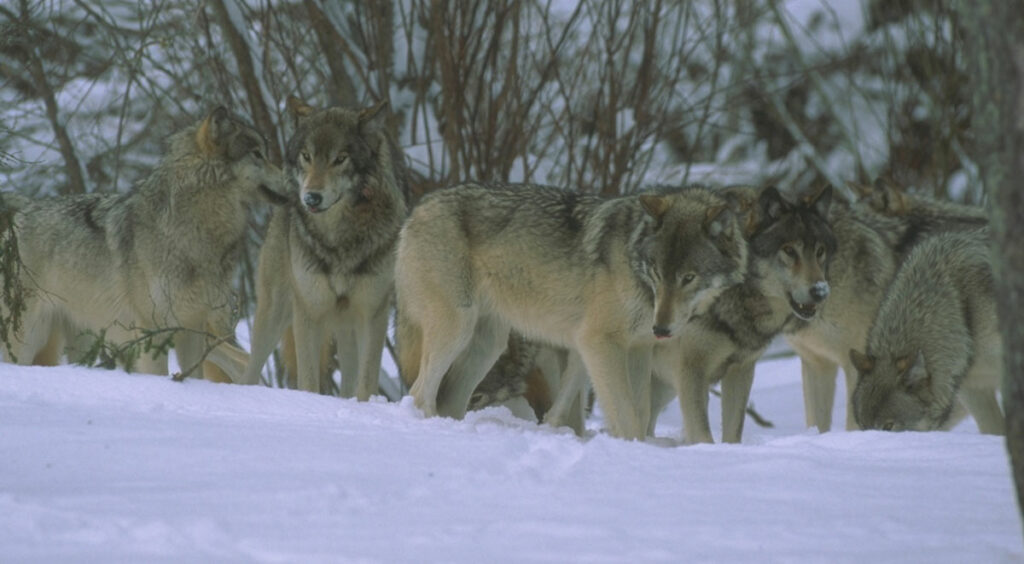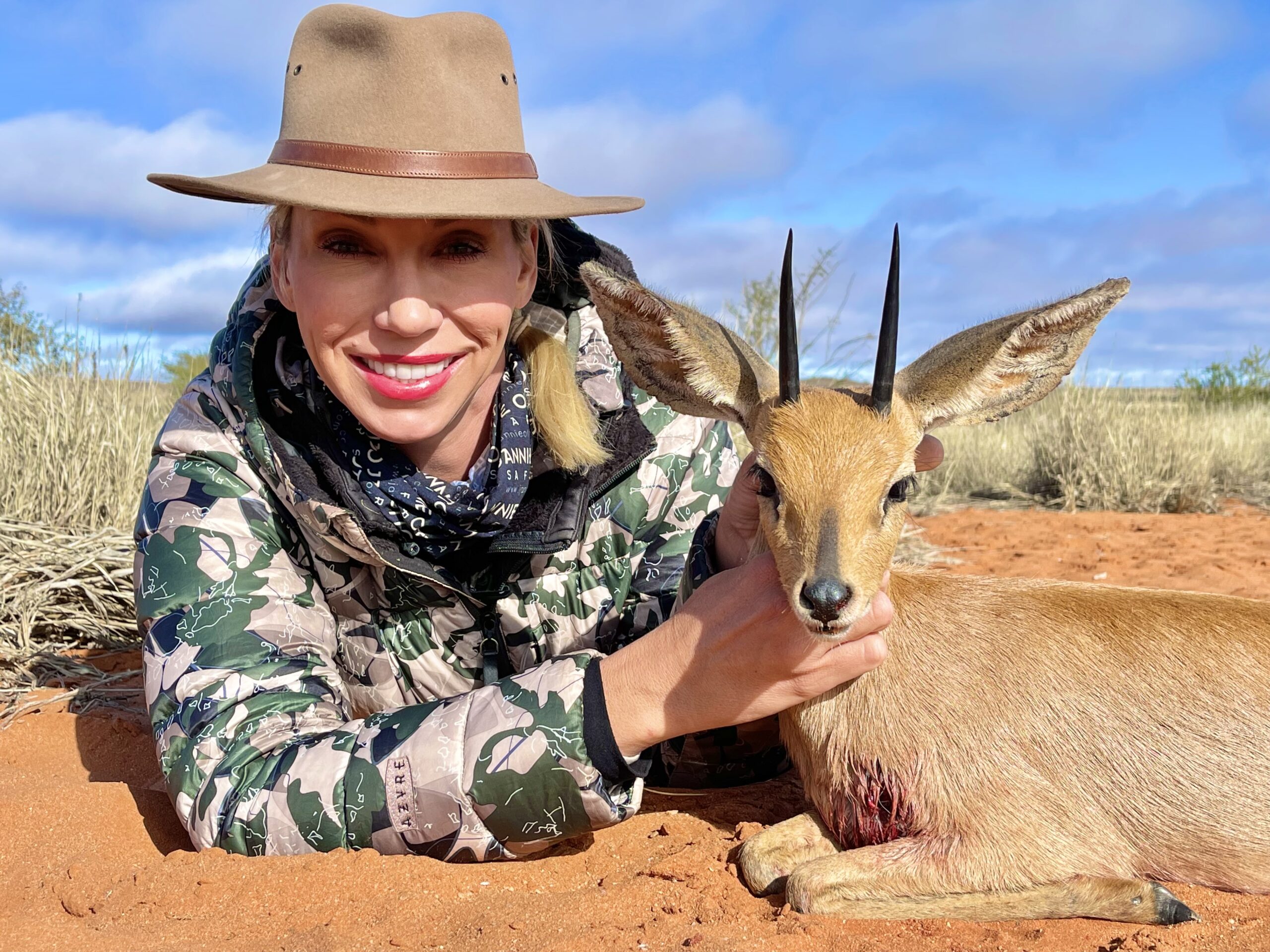SCI members know that gray wolves are no longer listed on the U.S. Endangered Species Act, as of Jan. 4, 2021.
In October 2020, U.S. Fish & Wildlife Service (FWS) announced the delisting, after which several anti-hunting groups immediately announced their intent to sue. Subsequently, three lawsuits have been filed in the U.S. District Court for the Northern District of California. Safari Club International (SCI), together with the National Rifle Association (NRA), is intervening in the suits and representing the voice of hunters across North America in wolf advocacy.
The suits are divided among three different animal rights groups. Natural Resources Defense Council filed independently, while the Western Environment Law Center filed a second suit on behalf of Wild Earth Guardians and a coalition of eight other organizations. Lastly, Earthjustice filed on behalf of Defenders of Wildlife, Center for Biological Diversity, Sierra Club, Humane Society of the United States, National Parks Conservation Association, and Oregon Wild.
The three suits challenge the delisting based on 20 different claims, but basically all argue that the federal government has not done enough to recover wolves across the vast majority of their former range of the continental United States.
SCI and the NRA) recently moved to intervene jointly in all three lawsuits to defend the delisting, wolf population recovery and the responsible transfer of wolf management to state wildlife management authorities.
The suits are assigned to the same judge, who has put them all on a concurrent timeline. A case management conference is scheduled for May for the judge to decide how the cases will proceed and set deadlines. The cases could take anywhere from six months to two years to adjudicate, depending on the filing of any emergency motions or appeals.
In the meantime, two wolf-related state controversies have emerged, due to the pending cases to relist. Both reflect a race to “beat the clock” on the possible relisting of wolves, one by a hunting group in Wisconsin, the other by wolf proponents in Colorado. Both have made headlines in the general media, often representing state wildlife managers and hunters as threats to the survival of wolves, while making wolf proponents out as saviors of an otherwise doomed species.
Wisconsin – Factors and Figures Behind a Controversial Hunt
The first case is that of Wisconsin’s rushed implementation of a renewed wolf hunting season and the subsequent over-subscription of the state-approved quota. After the announced delisting in October, the Wisconsin Department of Natural Resources (WDNR) announced the state would open an official wolf hunting season as required by Wisconsin law when the species was removed from the ESA list.
WDNR planned to conduct the hunt from November 2021 through February 2022, taking most of 2021 to hold the requisite stakeholder meetings (including the state’s Native American tribes), to incorporate stakeholder feedback in the hunt plans, and then to implement the hunt in line with Wisconsin’s wolf management plan.
SCI chose to support the state’s science-backed decision making in conducting its new hunting season. A Kansas-based hunting organization, however, requested the state hold the hunt right away, citing the Wisconsin law requiring the hunt.
When the WDNR policy board voted to stick with their original plan, a lawsuit ensued. According to the suit, a delayed season would rob hunters of the opportunity for a wolf hunt during the November 2020 to February 2021 season and beyond should the Biden Administration or the pending lawsuits in the Northern District of California succeed in relisting wolves before the November 2021 hunt date. In February, the Jefferson County Circuit Court interpreted the state statute as requiring the hunt to take place and ordered the state of Wisconsin to implement it.
At a Feb. 15 Natural Resources Board Special Meeting, a quota of 200 wolves was set, based on an updated population count using a more accurate occupancy model instead of the usual minimum winter counts.
Eighty-one wolves from the quota were allotted to the Ojibwe Tribe, who consider wolves sacred but, according to treaty, have the right to take up to half of the harvestable surplus in the Ceded Territory.
Hunters were officially issued a quota of 119 wolves. Dates were set for Feb. 22-28, 2021; the application period opened on Feb. 16 and it closed four days later on Feb. 20. Regulations were posted to the WDNR website Feb. 19.
More than 27,000 people applied for 2,380 harvest authorizations. The hunt opened on 22 February and was closed two days later on 24 February when hunters and trappers killed almost 100 more wolves than their quota – a total of 216 wolves.
What Wisconsin’s Numbers Really Mean
Immediately, anti-hunters raised the alarm that too many wolves had been killed, 20 percent of a population (based on the winter count of 1,034). One report presented the harvest number as 82 percent above the state goal.
They claimed that Wisconsin will decimate its wolf population this way, taking it back to the brink of extirpation. In reality, the DNR’s original quota of 200 (16 percent of the recalculated population of 1,195) was successfully met with the state’s goal of stabilizing the population.
Although a possible tribal harvest was not included in that number, it is not likely to be anywhere near the quota of 81 as the Ojibwe oppose hunting of wolves. Besides that, it’s important to know that the set quota objective of 200 was designed to allow for a sustainable harvest.
Combined with vehicle collisions and illegal take (approximately another 14 percent), WDNR state biologist Dave MacFarland says the harvest will stabilize the population, as per two previous studies. WDNR’s decision considered current population data, population responses to previous harvest seasons, scientific literature and population model projections.
The quota of 200 was conservative, and even with the over harvest on this hunt, it will have no significant or deleterious impact on the wolf population. Wolves can sustain heavy mortality rates, especially with Wisconsin’s dense deer herds, but at the expense of the state’s hunters.
It’s also important to point out that wolf populations in the Wisconsin/Michigan region surpassed federal recovery goals just over 20 years ago in the winter of 1999-2000 when they reached a combined total of 100 wolves for five consecutive years.
At delisting this past January, Wisconsin’s population alone was more than 10 times that number at 1,119 wolves. In 2001, Wisconsin’s wolf population surpassed the 250 mark, and the species was removed from the state’s list of threatened species (but remained federally listed despite meeting recovery goals).
By 2021, the population was four times over the Wisconsin management goal of 350 wolves. So, even if the hunt had permanently reduced the wolf population by 20 percent, it is still over eight times the federal recovery goals for the state and more than twice Wisconsin’s management goal.
Wisconsin’s wolves are concentrated mostly in the northern third of the state and the Central Forest area that make up the state’s suitable wolf habitat. Despite steady population growth, wolf expansion from these areas has been minimal in recent years, indicating they have already moved into most of the available wolf habitat in the state, according to WDNR.
Even though a wolf harvest has been held already this year, WDNR still plans to open a wolf season on Nov. 6, 2021. And while they have a state Wolf Management Plan that has successfully guided recovery efforts for the past 20 years, they are currently working on a 10-year plan to guide the state’s wolf management decisions moving forward.
SCI members will be represented on the planning committee. Wisconsin’s wolf population will continue to thrive, despite the manipulative interpretation of population and harvest numbers by animal rightists.
Colorado – A Race to Get Wolves on the Ground
In Colorado, there is also a rush over wolves, but this one is to reintroduce wolves to the state by the end of 2021. That’s what the wolf proponents are demanding of the Colorado Parks & Wildlife Department (CPW).
SCI members will recall that Colorado passed ballot initiative Proposition 114 in November 2020, charging the CPW with the task of reintroducing wolves to the state. This was in spite of SCI’s every effort with a coalition of partners and the department’s opposition to the proposal and the state’s lack of funding to implement a reintroduction. The initiative narrowly passed by 50.58 percent of the vote and is considered one of the most divisive issues in the state.
Proposition 114 requires CPW to designate lands west of the continental divide for reintroduction of wolves and to release wolves only in those designated lands. The areas must be selected according to a plan with public input. The plan must be designed to resolve conflicts with ranchers and farmers, including a compensation scheme for livestock owners who lose animals to wolf depredation.
The proposition specifically requires CPW to develop a plan using the best scientific data available, hold statewide hearings to acquire information for consideration in the development of the plan (including scientific, economic and social considerations), obtain public input to update the plan, source and reintroduce the wolves, and oversee their restoration and management.
The proposal gives CPW until the end of 2023 to reintroduce the animals, and the department has already begun a strategic phased approach to research and plan the reintroduction. The first step is to facilitate stakeholder engagement by establishing a Stakeholder Advisory Group (SAG) representing the diverse wolf management interests and develop a wolf management plan for the state.
SCI will also be represented on this group. “Stakeholder feedback will play an integral role in how we shape and conceptualize our statewide management plan for wolves,” says CPW Director Dan Prenzlow.
They are also convening a Technical Working Group comprised of members of governmental agencies or scientific specialists who bring expertise or unique knowledge of wolf reintroduction, wolf management, conflict minimization, depredation compensation and other relevant topics. The group will provide objective, scientific-based information and critical review in developing a wolf reintroduction and management plan while working with the SAG.
Relisting Suits Trigger Demands to Circumvent Proposition Requirements
Now that lawsuits have been filed to return the wolf to endangered status, wolf proponents are pressuring the CPW to finalize a three-year process in less than 12 months. This essentially violates the proposition’s requirements for a thoughtful and thorough planning process.
The reason for the rush is that the state would be completely barred from handling a federally listed endangered species and would likely be unable to conduct the reintroduction without federal approval and cooperation should wolves be relisted under the ESA.
The CPW has refused to rush the process, despite pressure from the governor and other politicians accountable to the mostly urban voters who supported the proposition. Although the decision to release wolves in Colorado was made by popular opinion and not science-based decision-making, the CPW is committed to conduct the actual release effort in as scientifically a manner as possible.
That cannot be done overnight, nor can it be done without budgeted funds, which are currently lacking. Even if it were possible to complete all the steps necessary for a properly conducted species reintroduction, they simply do not have the funds to pay for it.
What SCI Members Can Do
Whether its issues with wolves, bears, wild cats, pigs or a favorite ungulate, hunters need to stay informed and engaged in their states’ management policies. That means getting involved in the game commission’s process.
This is especially true in places like Colorado. The fight at the ballot box is over there, but it has now shifted to how CPW will respond to new demands in the process of reintroducing and managing wolves.
SCI members in Colorado must attend commission meetings about wolf reintroduction and make their interests known and voices heard. “Tell the SAG exactly how you feel about having wolves in your backyard,” says Cyrus Baird, SCI’s Manager of Government Relations. “Tell them that if wolves remain unlisted, hunting should be one of the tools to manage their populations and the opportunities should be made available as soon as it is possible.”
The same involvement applies in Wisconsin, where a wolf advisory group will be meeting regularly. In fact, Baird urges hunters in every state to sign-up for email and text notices from their state’s game commission regarding all their meetings.
This is where issues affecting hunters are discussed and where policy is often decided. Hunters should attend those meetings, provide feedback and make sure commission members understand how proposed policies affect stakeholders. Anti-hunters certainly do it. Visit the state wildlife department’s website and look for information on commission meetings to sign-up for notices.
Also, sign-up for SCI’s Hunter Advocacy Action Center (HAAC) to receive text and email alerts about issues affecting hunting at both state and federal levels. HAAC also allows members to communicate directly with government representatives about these issues.
When the federal suits challenging the delisting were announced in January and wolf preservation proponents began demanding the immediate release of wolves in Colorado, the HAAC sent SCI members in Colorado an alert.
CPW commission members received 2,000 emails insisting they stick to science-guided action and the stakeholder engagement process. Because of this, commissioners stood their ground on taking the full time allotted by Proposition 114 to reintroduce wolves to Colorado.
Through grassroots efforts like this and SCI’s advocacy work in court, state legislatures and the U.S. Congress, along with science-based research funded by SCIF, hunting and sustainable use conservation will remain the key tools of wildlife management in the North American conservation model.–Barbara Crown, SCI Hunter Information Service Liaison




